National Parks, Nature Refuges, Private Reserves, State Forests
Wildlife after severe fire in springtime in mountain forests of SEQ: a few notes
The advice provided in this article is for private land only, and perhaps Council land with permission. National Parks have a strictly hands-off policy, so nothing should be provided there.
Fire is a natural phenomenon in many Australian ecosystems. Many of our open forest and heathland plants have adaptations to deal with it, and many of our animals can readily escape a slow moving fire, their populations bouncing back shortly thereafter.
However, very severe fires can have very severe consequences. There are then two problems for our wildlife:
• the welfare of individual animals that are wounded, orphaned or that have survived the fire but now cannot find enough food and are more vulnerable to predators because of the lack of shelter
• conservation of populations: if the fire is sufficiently fierce and widespread, especially in areas of fragmented habitat, it has the potential to eliminate local populations of the species either by mortality during the fire or by destroying the resources they need.
Death is normal in natural ecosystems, as in human societies, and we can’t change that. Most animals never live to adulthood – they are caught by predators, succumb to parasites or diseases, or starve. Old animals become more susceptible to all of these problems (old koalas often end up starving because their teeth have been worn down too much to chew eucalypt leaves). Everything and everyone dies eventually. Sad perhaps, but again nothing we can do about it and we could cause more problems by trying. In normal circumstances we shouldn’t alter anything in natural habitats.
I would thus not normally suggest feeding wildlife, especially in natural or near-natural areas: it can cause all kinds of problems. However, natural disasters, sometimes accentuated by human activities (including climate change) can put unusually high pressures on our wildlife for short periods.
Here are some of the animals that could especially need a helping hand during or after a severe event such as our recent fires, followed by some we should avoid helping.
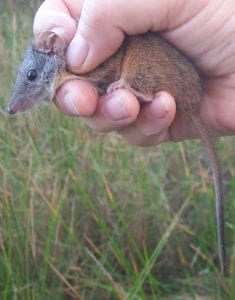
Antechinus
Antechinuses are small carnivorous/insectivorous marsupials – small cousins of quolls and Tasmanian devils. The one pictured here is a yellow-footed antechinus of the open forests, but the rainforests harbour other, related species. They may look like mice but they have sharp carnivore-style teeth and eat mice, along with small lizards and insects, worms etc.
Mobility: With their short legs they can’t run very far very quickly, but if the fire is not too hot they can hide under logs etc. as it approaches. After a fire that eliminates much of their insect prey, they can’t range wide areas to seek food. They mate in late winter and early spring, and soon all males die off, with females living on to raise the family. By mid-spring each female is either burdened with several babies firmly attached to her teats, making it even harder to travel far, or she has the relief of finally being able to leave them in a nest while she forages, but again can’t go far because she has to return to feed them.
Problems after fire: Lack of mobility, lack of invertebrate prey amongst leaf litter, lack of cover of low vegetation and thus vulnerability to predators.
How to help: Dry dogfood or dried mealworms scattered thinly amongst leaf litter. A TINY amount of peanut butter, sausage, bacon, sardine or linseed oil could help attract their attention by smell: do NOT attract their predators (dingos, dogs, foxes, cats) by supplying any large or conspicuous pieces (placed under a log is best). Water should also be provided, to counteract the dryness of the food offered. If shelter is severely compromised, local logs could also be provided.
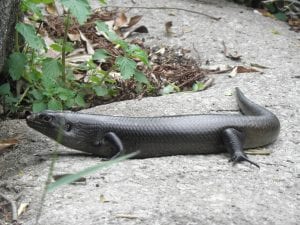
Lizards
Skinks are the most numerous lizards in Australia, both in individuals and number of species. They typically have small, weak legs. Most are quite small (10cm or so). Even the largest skink in Australia, the land mullet, can’t travel long distances to find food after a devastating fire, and nor can its slightly smaller cousins in the rainforests and adjoining eucalypt forests, the major skink and the pink-eared skink. Geckos mostly live in the trees and can go higher to escape fires that just burn quietly through the lower layers, but are in trouble in canopy fires, and have the same problems as other small lizards afterwards. Dragon lizards can travel a bit further, but by doing so may intrude on the territories of other dragons. Goannas are the largest lizards, but with their lumbering, prehistoric gait also have their limits on how far they can travel to find more food.
Problems and how to help: as for Antechinus
Small insectivorous birds
Small birds such as scrubwrens and log-runners may also find it difficult to find food after a severe fire. They are more mobile than the antechinus and lizards, but their mobility is limited and they may not be able to simply move into neighbouring forest, because once again they may be occupied by other members of their species guarding their territories, especially in spring when everything is breeding.
Other birds are returning from the valleys in spring ready for breeding in mountain forests and also trying to find resources that may simply not be available in sufficient quantities to feed a family of hungry nestlings.
Problems and how to help: as for those above.
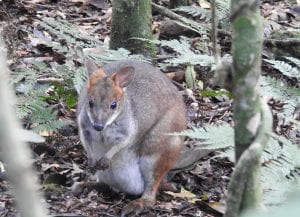
Pademelons, potoroos and bandicoots
Kangaroos and wallabies can move long distances in search of food (challenged in some localities), the smaller macropods and potorids less so. Red-necked pademelons often rely on leaving the rainforest to forage, especially at dusk and dawn, on grasses, and red-legged pademelons will do the same but less often, mostly staying in the forest eating other leaves.
How to help: If the grass beside a forest has been affected by fire, or if many understorey plants have been affected, they can be given a temporary boost (until plant life recovers) by thinly scattering pony pellets (or better still macropod pellets) amongst the leaf litter. This, combined with small dried dogfood or dried mealworms, will also assist bandicoots and potoroos, which are omnivorous.
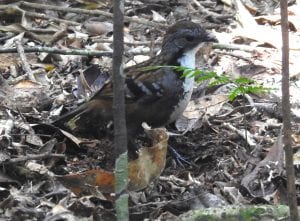
Hollow-nesters
Possums, including gliders, parrots, native bees and other species may lose trees with hollows. A few artificial nest-boxes may help these through the tough times, especially in breeding season. Small animals such as sugar gliders and feather tail gliders will find it hard to compete with larger species, and tree-climbing predators such as goannas and carpet pythons can also enter, so it is important to include a few boxes with small openings (e.g. 3.4cm diameter) and if possible face the opening towards the tree trunk, with of course something to hold the box slightly away from the trunk so these tiny creatures can climb in but their larger competitors and predators will be more challenged by.
What NOT to help
Number one is the currawong. They are large birds, powerful flyers, omnivorous and very adaptable, so although individuals may well be hungry they’ll mostly do just fine. The animals they prey on won’t. Same goes for kookaburras and crows.
Small lizards that have to expose themselves on the forest floor when foraging for food are easy prey for feathered predators, which often do very well just after a fire because of the small vertebrates and large invertebrates that have survived but lack shelter.
Probably the greatest problem though is the raiding of nests. The small birds may be finding it very tough anyway to raise their broods following fire and/or drought, and it may well be impossible for them to do so if they are also faced with these predatory birds that are constantly on the lookout for eggs and nestlings to eat. In the New England district of NSW, the currawongs used to go to the lowlands for winter, until residents started growing winter-fruiting plants such as hawthorns and cotoneasters, which encouraged them to stay year-round. Some local patches of bushland have, as a result, lost 100% of all nestlings in some years.
This is why I’m recommending a light scattering of food amongst leaf litter or under logs or dense plants. A large pile of food, or even the scattering of small pieces of food on open ground will be readily seen by currawongs, crows, butcherbirds, kookaburras and others it would be better NOT to encourage, if we are to help the antechinus, small lizards and small birds mentioned above.
There are also large birds and mammals such as brush turkeys and brush tailed possums that are very adaptable and can probably take care of themselves much better than those discussed above (and brush tailed possums do also raid bird nests). While it is not so bad to feed these as feeding currawongs, they are not the priority.
Experiments
I wanted to be careful to assist the creatures most in need without making things worse for them by feeding too many of their more mobile competitors and worse still their major predators. With assistance of a couple of local folk (especially Barry Davies and Alinta Krauth) we set up motion sensing cameras to see if scattering as suggested above could work. When conspicuous food was presented it was soon eaten by currawongs and crows, precisely what we don’t want to happen. When spread thinly and inconspicuously in leaf litter (some of it close to burned areas) it was soon found by bandicoots, pademelons, bowerbirds, whipbirds, goannas and others, but not currawongs, crows or dingos.
No antechinus – maybe they have already all died from drought or fire-induced lack of insect life at a hard time for the new mothers, or maybe they just don’t find the dog pellets and mealworms as readily as other more wide-ranging foragers. This is why I’m suggesting a tiny bit of peanut butter under logs or dense ground-hugging plants. If this fails to attract their attention, other lures used for trapping them during field surveys have included such things as sausage, salami, bacon, sardines or leather soaked in linseed oil. If using any of those though, it has to be a TINY amount or it could also attract dingos, dogs, cats and foxes. We’re not trying to actually feed them with those foods, just attract their attention to the food we are providing for them.
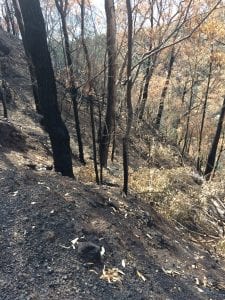 Burnt areas
Burnt areas
I haven’t yet experimented with providing food amongst the ashes of the badly burned areas. They seemed just so bare initially that there’s probably not much surviving there now or trying to use them, and any food scattered there may be too readily seen by currawongs, crows, etc.
I would suggest some experimental scattering under logs or under any greenery that starts to appear after the first rains, especially where local species are known to have occurred previously, and gradually extending further into the burned areas as they start to recover.
How long and where to help?
We’ve been in a very long drought and now the fires have made things harder for the animals. The forecast is predicting more drought and more high temperatures. Although we do not wish to make these animals dependent on handouts, I would suggest continuing some amount of supplementary feeding and provision of water (in shallow bowls with rocks or branches that small skinks can climb out on so they don’t drown) until the worst of the summer droughts are over, perhaps till the end of February depending on what the weather is doing, gradually trailing off until conditions improve. If we are surprised by a couple of weeks of good rainfall, and quick recovery of plants and insects, that may not be necessary.
The advice is for private land only, and perhaps Council land with permission. National Parks have a strictly hands-off policy, so nothing should be provided there.


